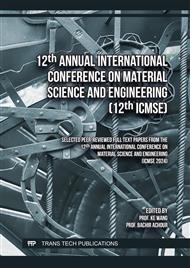[1]
Y.B. Shu, L.Y. Zhang, and Y.Z. Zhang et al. "Carbon Peak and Carbon Neutrality Path for China's Power Industry," Strategic Study of CAE, vol.23, no.6, pp.001-014, Dec.2021.
Google Scholar
[2]
H. Bian, C. Zhou, Z. Guo, Y. Zhou and Q. Ren, "Coordinated Planning of Electricity-Hydrogen Integrated Energy System Considering Lifecycle Carbon Emissions," in IEEE Access, vol. 12, pp.33889-33909, 2024.
DOI: 10.1109/access.2024.3373189
Google Scholar
[3]
G. Liu, Y. Tao, Z. Ge, J. Qiu, F. Wen and S. Lai, "Data-Driven Carbon Footprint Management of Electric Vehicles and Emission Abatement in Electricity Networks," in IEEE Transactions on Sustainable Energy, vol. 15, no. 1, pp.95-108, Jan. 2024.
DOI: 10.1109/tste.2023.3274813
Google Scholar
[4]
S. Benjaafar, Y. Li and M. Daskin, "Carbon Footprint and the Management of Supply Chains: Insights From Simple Models," in IEEE Transactions on Automation Science and Engineering, vol. 10, no. 1, pp.99-116, Jan. 2013.
DOI: 10.1109/tase.2012.2203304
Google Scholar
[5]
Y. Fuyuan, "Research on Power Carbon Emission Accounting Method for a New Type of Power System Construction," 2023 6th Asia Conference on Energy and Electrical Engineering (ACEEE), Chengdu, China, 2023, pp.551-556.
DOI: 10.1109/aceee58657.2023.10239674
Google Scholar
[6]
M. Pourakbari-Kasmaei, M. Lehtonen, J. Contreras and J. R. S. Mantovani, "Carbon Footprint Management: A Pathway Toward Smart Emission Abatement," in IEEE Transactions on Industrial Informatics, vol. 16, no. 2, pp.935-948, Feb. 2020.
DOI: 10.1109/tii.2019.2922394
Google Scholar
[7]
A. Besancon-Voda and C. Delclos, "Control of semicontinuous aluminum casting process," in IEEE Transactions on Control Systems Technology, vol. 6, no. 2, pp.233-245, March 1998.
DOI: 10.1109/87.664190
Google Scholar
[8]
J. Tuo, P. Liu and F. Liu, "Dynamic Acquisition and Real-Time Distribution of Carbon Emission for Machining Through Mining Energy Data," in IEEE Access, vol. 7, pp.78963-78975, 2019.
DOI: 10.1109/access.2019.2919564
Google Scholar
[9]
W. Chen, Y. Ma and C. Bai, "The Impact of Carbon Emission Quota Allocation Regulations on the Investment of Low-Carbon Technology in Electric Power Industry Under Peak-Valley Price Policy," in IEEE Transactions on Engineering Management, vol. 71, pp.374-391, 2024.
DOI: 10.1109/tem.2021.3121002
Google Scholar
[10]
X. Zhao, Y. Shang, X. Ma, P. Xia and U. Shahzad, "Does Carbon Trading Lead to Green Technology Innovation: Recent Evidence From Chinese Companies in Resource-Based Industries," in IEEE Transactions on Engineering Management, vol. 71, pp.2506-2523, 2024.
DOI: 10.1109/tem.2022.3186905
Google Scholar



